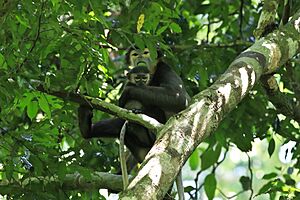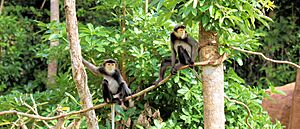Black-shanked douc facts for kids
Quick facts for kids Black-shanked douc |
|
|---|---|
 |
|
| Black-shanked douc with baby at Cát Tiên National Park | |
| Conservation status | |
| Scientific classification | |
| Genus: |
Pygathrix
|
| Species: |
nigripes
|
 |
|
| Black-shanked douc range | |
The black-shanked douc (Pygathrix nigripes) is a type of monkey. It is a very rare and critically endangered animal. You can find it mostly in the forests of eastern Cambodia. There are also some smaller groups in southern Vietnam. These monkeys live in the Annamite Range, which is a mountainous area. They spend most of their time high up in the trees. Black-shanked doucs move around on all fours or by swinging through the branches.
This monkey is special because of its bright colors. It has a bluish face with yellow rings around its eyes. Like other doucs, its tail is as long as its head and body combined. Black-shanked doucs live in groups. These groups can be as small as 3 monkeys or as large as 30. The group size often changes depending on how much food is available.
Their diet changes with the seasons. They mostly eat leaves. But in the wet season, they also enjoy lots of fruits and flowers. In 2015, the black-shanked douc's conservation status became worse. It went from "endangered" to "critically endangered." This means its population is shrinking very quickly. Most of these monkeys live in Cambodia. A large group of about 25,000 lives in Cambodia's Keo Seima Wildlife Sanctuary. This group has stayed stable for the last ten years. In Vietnam, there are only about 500-600 individuals left. The biggest dangers to the black-shanked douc are losing their homes and illegal hunting. People are working to protect them by making laws against hunting and trading these special animals.
Contents
Where Black-shanked Doucs Live
Doucs are a type of monkey found only in Southeast Asia. They live in countries like Cambodia, Laos, and Vietnam. The black-shanked douc, however, is only found in Cambodia and Vietnam. Scientists have found that different douc species live in different parts of Vietnam, from north to south.
The black-shanked douc lives in a specific narrow area. This area is between 11° N and 13.5° N latitude. It covers eastern Cambodia and southern Vietnam. They can live in many types of forests. These include evergreen forests and mixed forests. Most doucs, including the black-shanked douc, live in the Annamite Range. This is a mountain range in eastern Indochina.
Black-shanked doucs are "arboreal," meaning they live in trees. They move by walking on all fours or by swinging from branch to branch. They usually stay in the middle or upper parts of the forest canopy. They have been seen from sea level up to 1500 meters high. However, many lower forests have been cut down. So, most sightings now happen at higher elevations.
What Black-shanked Doucs Look Like
All douc monkeys are known for their colorful fur. The black-shanked douc has special colors on its head and neck. These colors help tell it apart from other douc species. Its most unique feature is its bluish face with big yellow rings around its eyes. It also has short, thin whiskers.
Around its face, there is a thin chestnut-colored outline. The back of its head is black. The area around its throat is white. Its back is dark grey, and its belly is light grey. Most of its arms and legs are black.
Sometimes, a few black-shanked doucs have different colors. For example, their forearms might be partly or completely white. Their lower legs might be dark red. Scientists think these color changes might happen if different douc species have babies together.
The black-shanked douc's tail is as long as its head and body. Male black-shanked doucs are about 50 cm long (head and body). Their tails are about 690 cm long, and they weigh about 5.3 kg. Female black-shanked doucs are about 56 cm long (head and body) and weigh about 5.4 kg.
How Black-shanked Doucs Behave
Black-shanked doucs live in different kinds of social groups. Some groups have one male, several females, and their young. These groups usually have about 7 or 8 monkeys. The male is usually in charge. There are also groups of only males.
Their social system is called "fission-fusion." This means that groups can split apart and then come back together. This often happens in the wet season when there is more food. Group sizes can vary a lot, from 3 to 35 monkeys. The size of a group often depends on how good their habitat is. It also depends on how much humans disturb them. Larger groups often have more males than females.
What Black-shanked Doucs Eat
Black-shanked doucs are mostly "folivorous." This means they mainly eat leaves. Studies in Cambodia and Vietnam show they eat leaves from many different types of plants. They don't seem to prefer certain plants. They just eat whatever is available. They have been seen eating from as many as 150 different plant species!
Besides leaves, they also eat fruits, flowers, and seeds. The amount of these foods changes with the seasons. In the dry season, they eat more leaves. They eat fewer fruits and flowers. In the wet season, they eat a wider variety of leaves. They also eat more fruits and flowers. This is because these foods are more common when it's wet.
They also eat different foods at different times of the day. They eat leaves steadily throughout the day. But they eat more fruits before midday. This helps them get energy for the morning.
Protecting Black-shanked Doucs
In 2000, the black-shanked douc was listed as "Endangered." This was because its population was shrinking. But in 2015, its status changed to "Critically Endangered." This means its population is declining even faster.
The main reasons for this decline are habitat loss and habitat fragmentation. This means their forest homes are being destroyed and broken into smaller pieces. Other threats include illegal hunting and wildlife trade. While serious, these are not as damaging as losing their habitat.
In Vietnam, a lot of forests were cut down in the 20th century. This was due to farming, timber, and mining. After the Vietnam War, even more forests were cleared for farms. Cities also grew, turning forests into urban areas. Even today, protected areas are illegally turned into farms.
Illegal hunting and wildlife trade are big problems for monkeys in Vietnam. Monkeys are hunted for food, medicine, and to be sold as pets. Even though these actions are against the law, they still happen in Vietnam and Cambodia. To help, Vietnam has made laws to control guns. They also forbid hunting and trading endangered animals.
Climate change is also a worry for the black-shanked douc. Animals that live in only one small area are more at risk from climate change. Scientists believe the black-shanked douc will be vulnerable as global temperatures rise. Its current home is already shrinking. It will be hard for them to find new suitable places to live as the climate changes.



